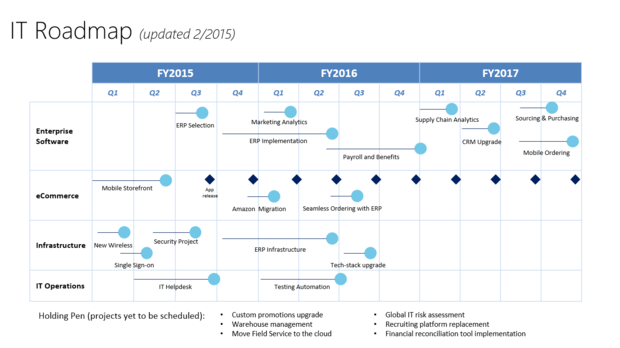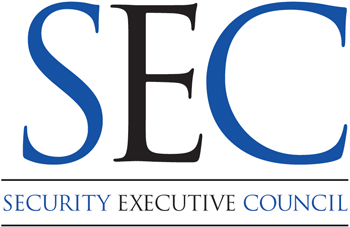Created by the Security Executive Council
A roadmap is a method of strategic planning that visually communicates a plan for initiatives at an organization. Organizations of all types can use roadmaps to optimize costs, advance mission performance, and coordinate efforts.
Within the security function, a technology roadmap can outline how total cost of ownership of technology, such as GSOC innovations like analytic audio/video/access control and mobile safety communications, can be managed while continuously improving risk outcomes.
The roadmap lays out implementation in phases and links each action with accountable managers, performance targets, and ROI milestones. It also helps visually align planned services and technologies within organizational goals.

This example of a technology roadmap was sourced from: https://images.techhive.com/images/article/2015/02/it-roadmap-100570209-large.idge.png
Why might I need one?
Too often, technology is implemented without regard to future service considerations like acquisition integrations, managing innovation or obsolescence. Failure to plan drives more costly upgrades that often decrease operational ROI.
What could I gain?
- Project prioritization. The process helps teams set goals and prioritize initiatives and tasks.
- Coordination. Technology can be planned across functions to ensure coordinated, open-architecture, and integrated/interoperable performance.
- Investments and business cases for technology may be laid out in advance. Resources and funds can be approved and earmarked early with fewer surprises.
- Strategic alignment. The roadmap builds upon and interacts with enterprise strategic plans to ensure all investments line up with organizational goals.
- Scalability and flexibility. Long-term planning and operational concept proofing allow implementations to be timed to meet the needs of the organization.
- Accountability. Clearly outlines ownership and governance for new service and technology investments.
- A tool for decision making. Much like a five-year strategic plan, a service technology roadmap can be used as a decision-making tool. Only proposed implementations that fit into the overall long-term strategy should be considered or trialed.
- A tool for vendor evaluation and selection. Solution innovation partners and vendors can be chosen based on their short-term pilot performance and longer-term value contribution requirements (KPIs) laid out in the roadmap.
How do I start?
- Gather a team. Begin with operational leaders inside the function, then expand to include external stakeholders who value uninterrupted, continuously improving service performance.
- Identify business-aligned strategic goals and initiatives.
- Document what you want to achieve, for example:
- Reduce risk/optimize performance
- Increase productivity/mitigate business interruption
- Gather data for reporting metrics/improve objective performance
- Enterprise integration and interoperability improvement
- Cost savings with net new revenue protection
- Compliance plus brand reputation equity
- Look at where your technology services are presently and where you want to go for optimal value and efficiencies.
- Define needs and priorities. What technology is must-have, and what is like-to-have?
- Evaluate any service provider/vendor based on performance requirements.
- Estimate total cost of ownership and milestone resource dependencies.
- Set realistic timelines for each phase.
- Follow up. Require regular status reports and clear metrics from accountable leaders.
Next Steps
The Security Executive Council has assisted many security leaders in developing, refining and utilizing technology roadmaps.
Contact Us to discuss your plans and how we might be able to help you achieve your vision.

